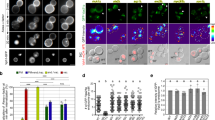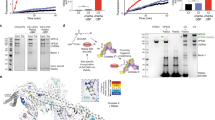Abstract
Transport protein particle (TRAPP; also known as trafficking protein particle), a multimeric guanine nucleotide-exchange factor for the yeast GTPase Ypt1 and its mammalian homologue, RAB1, regulates multiple membrane trafficking pathways. TRAPP complexes exist in three forms, each of which activates Ypt1 or RAB1 through a common core of subunits and regulates complex localization through distinct subunits. Whereas TRAPPI and TRAPPII tether coated vesicles during endoplasmic reticulum to Golgi and intra-Golgi traffic, respectively, TRAPPIII has recently been shown to be reqiured for autophagy. These advances illustrate how the TRAPP complexes link Ypt1 and RAB1 activation to distinct membrane-tethering events.
This is a preview of subscription content, access via your institution
Access options
Subscribe to this journal
Receive 12 print issues and online access
$189.00 per year
only $15.75 per issue
Buy this article
- Purchase on Springer Link
- Instant access to full article PDF
Prices may be subject to local taxes which are calculated during checkout


Similar content being viewed by others
References
Palade, G. Intracellular aspects of the process of protein synthesis. Science 189, 347–358 (1975).
Bonifacino, J. S. & Glick, B. S. The mechanisms of vesicle budding and fusion. Cell 116, 153–166 (2004).
Lee, M. C., Miller, E. A., Goldberg, J., Orci, L. & Schekman, R. Bi-directional protein transport between the ER and Golgi. Annu. Rev. Cell Dev. Biol. 20, 87–123 (2004).
Cai, H., Reinisch, K. & Ferro-Novick, S. Coats, tethers, Rabs, and SNAREs work together to mediate the intracellular destination of a transport vesicle. Dev. Cell 12, 671–682 (2007).
Gillingham, A. K. & Munro, S. Long coiled-coil proteins and membrane traffic. Biochim. Biophys. Acta 1641, 71–85 (2003).
Whyte, J. R. & Munro, S. Vesicle tethering complexes in membrane traffic. J. Cell Sci. 115, 2627–2637 (2002).
Grosshans, B. L., Ortiz, D. & Novick, P. Rabs and their effectors: achieving specificity in membrane traffic. Proc. Natl Acad. Sci. USA 103, 11821–11827 (2006).
Bacon, R. A., Salminen, A., Ruohola, H., Novick, P. & Ferro-Novick, S. The GTP-binding protein Ypt1 is required for transport in vitro: the Golgi apparatus is defective in ypt1 mutants. J. Cell Biol. 109, 1015–1022 (1989).
Baker, D., Wuestehube, L., Schekman, R., Botstein, D. & Segev, N. GTP-binding Ypt1 protein and Ca2+ function independently in a cell-free protein transport reaction. Proc. Natl Acad. Sci. USA 87, 355–359 (1990).
Barlowe, C. Coupled ER to Golgi transport reconstituted with purified cytosolic proteins. J. Cell Biol. 139, 1097–1108 (1997).
Sacher, M. et al. TRAPP, a highly conserved novel complex on the cis-Golgi that mediates vesicle docking and fusion. EMBO J. 17, 2494–2503 (1998).
Jahn, R. & Scheller, R. H. SNAREs — engines for membrane fusion. Nature Rev. Mol. Cell Biol. 7, 631–643 (2006).
Sacher, M. et al. TRAPP I implicated in the specificity of tethering in ER-to-Golgi transport. Mol. Cell 7, 433–442 (2001).
Montpetit, B. & Conibear, E. Identification of the novel TRAPP associated protein Tca17. Traffic 10, 713–723 (2009).
Scrivens, P. J. et al. TRAPPC2L is a novel, highly conserved TRAPP-interacting protein. Traffic 10, 724–736 (2009).
Miller, E. A. et al. Multiple cargo binding sites on the COPII subunit Sec24p ensure capture of diverse membrane proteins into transport vesicles. Cell 114, 497–509 (2003).
Cai, H. et al. TRAPPI tethers COPII vesicles by binding the coat subunit Sec23. Nature 445, 941–944 (2007).
Cai, H., Zhang, Y., Pypaert, M., Walker, L. & Ferro-Novick, S. Mutants in trs120 disrupt traffic from the early endosome to the late Golgi. J. Cell Biol. 171, 823–833 (2005).
Yamasaki, A. et al. mTrs130 is a component of a mammalian TRAPPII complex, a Rab1 GEF that binds to COPI-coated vesicles. Mol. Biol. Cell 20, 4205–4215 (2009).
Gedeon, A. K. et al. Identification of the gene (SEDL) causing X-linked spondyloepiphyseal dysplasia tarda. Nature Genet. 22, 400–404 (1999).
Mir, A. et al. Identification of mutations in TRAPPC9, which encodes the NIK- and IKK-β-binding protein, in nonsyndromic autosomal-recessive mental retardation. Am. J. Hum. Genet. 85, 909–915 (2009).
Mochida, G. H. et al. A truncating mutation of TRAPPC9 is associated with autosomal-recessive intellectual disability and postnatal microcephaly. Am. J. Hum. Genet. 85, 897–902 (2009).
Philippe, O. et al. Combination of linkage mapping and microarray-expression analysis identifies NF-κB signaling defect as a cause of autosomal-recessive mental retardation. Am. J. Hum. Genet. 85, 903–908 (2009).
Gwynn, B., Smith, R. S., Rowe, L. B., Taylor, B. A. & Peters, L. L. A mouse TRAPP-related protein is involved in pigmentation. Genomics 88, 196–203 (2006).
Yu, S. et al. mBet3p is required for homotypic COPII vesicle tethering in mammalian cells. J. Cell Biol. 174, 359–368 (2006).
Loh, E., Peter, F., Subramaniam, V. N. & Hong, W. Mammalian Bet3 functions as a cytosolic factor participating in transport from the ER to the Golgi apparatus. J. Cell Sci. 118, 1209–1222 (2005).
Sacher, M., Barrowman, J., Schieltz, D., Yates, J. R. & Ferro-Novick, S. Identification and characterization of five new subunits of TRAPP. Eur. J. Cell Biol. 79, 71–80 (2000).
Allan, B. B., Moyer, B. D. & Balch, W. E. Rab1 recruitment of p115 into a cis-SNARE complex: programming budding COPII vesicles for fusion. Science 289, 444–448 (2000).
Bentley, M. et al. SNARE status regulates tether recruitment and function in homotypic COPII vesicle fusion. J. Biol. Chem. 281, 38825–38833 (2006).
Kummel, D., Oeckinghaus, A., Wang, C., Krappmann, D. & Heinemann, U. Distinct isocomplexes of the TRAPP trafficking factor coexist inside human cells. FEBS Lett. 582, 3729–3733 (2008).
Koumandou, V. L., Dacks, J. B., Coulson, R. M. & Field, M. C. Control systems for membrane fusion in the ancestral eukaryote; evolution of tethering complexes and SM proteins. BMC Evol. Biol. 7, 29 (2007).
Lynch-Day, M. A. et al. Trs85 directs a Ypt1 GEF, TRAPPIII, to the phagophore to promote autophagy. Proc. Natl Acad. Sci. USA 107, 7811–7816 (2010).
Cai, Y. et al. The structural basis for activation of the Rab Ypt1p by the TRAPP membrane-tethering complexes. Cell 133, 1202–1213 (2008).
Kim, Y. G. et al. The architecture of the multisubunit TRAPP I complex suggests a model for vesicle tethering. Cell 127, 817–830 (2006).
Morozova, N. et al. TRAPPII subunits are required for the specificity switch of a Ypt-Rab GEF. Nature Cell Biol. 8, 1263–1269 (2006).
Robinett, C. C., Giansanti, M. G., Gatti, M. & Fuller, M. T. TRAPPII is required for cleavage furrow ingression and localization of Rab11 in dividing male meiotic cells of Drosophila. J. Cell Sci. 122, 4526–4534 (2009).
Wang, W. & Ferro-Novick, S. A Ypt32p exchange factor is a putative effector of Ypt1p. Mol. Biol. Cell 13, 3336–3343 (2002).
Yip, C. K., Berscheminski, J. & Walz, T. Molecular architecture of the TRAPPII complex and implications for vesicle tethering. Nature Struct. Mol. Biol. (in the press).
Segev, N., Mulholland, J. & Botstein, D. The yeast GTP-binding YPT1 protein and a mammalian counterpart are associated with the secretion machinery. Cell 52, 915–924 (1988).
Sclafani, A. et al. Establishing a role for the GTPase Ypt1p at the late Golgi. Traffic 11, 520–532 (2010).
Nakatogawa, H., Suzuki, K., Kamada, Y. & Ohsumi, Y. Dynamics and diversity in autophagy mechanisms: lessons from yeast. Nature Rev. Mol. Cell Biol. 10, 458–467 (2009).
Hamasaki, M. & Yoshimori, T. Where do they come from? Insights into autophagosome formation. FEBS Lett. 584, 1296–1301 (2010).
Meiling-Wesse, K. et al. Trs85 (Gsg1), a component of the TRAPP complexes, is required for the organization of the preautophagosomal structure during selective autophagy via the Cvt pathway. J. Biol. Chem. 280, 33669–33678 (2005).
Nazarko, T. Y., Huang, J., Nicaud, J. M., Klionsky, D. J. & Sibirny, A. A. Trs85 is required for macroautophagy, pexophagy and cytoplasm to vacuole targeting in Yarrowia lipolytica and Saccharomyces cerevisiae. Autophagy 1, 37–45 (2005).
Behrends, C., Sowa, M. E., Gygi, S. P. & Harper, J. W. Network organization of the human autophagy system. Nature 466, 68–76 (2010).
Yen, W. L. et al. The conserved oligomeric Golgi complex is involved in double-membrane vesicle formation during autophagy. J. Cell Biol. 188, 101–114 (2010).
Cao, X., Ballew, N. & Barlowe, C. Initial docking of ER-derived vesicles requires Uso1p and Ypt1p but is independent of SNARE proteins. EMBO J. 17, 2156–2165 (1998).
Yamakawa, H., Seog, D. H., Yoda, K., Yamasaki, M. & Wakabayashi, T. Uso1 protein is a dimer with two globular heads and a long coiled-coil tail. J. Struct. Biol. 116, 356–365 (1996).
Hughson, F. M. & Reinisch, K. M. Structure and mechanism in membrane trafficking. Curr. Opin. Cell Biol. 22, 454–460 (2010).
Acknowledgements
Salary support for J.B. is provided by US National Institutes of Health (NIH) grant R01 GM41223. Salary support for S.F.-N., and D.B. is provided by the Howard Hughes Medical Institute. Salary support for K.R. is provided by NIH grant R01 GM80616.
Author information
Authors and Affiliations
Corresponding author
Ethics declarations
Competing interests
The authors declare no competing financial interests.
Related links
Rights and permissions
About this article
Cite this article
Barrowman, J., Bhandari, D., Reinisch, K. et al. TRAPP complexes in membrane traffic: convergence through a common Rab. Nat Rev Mol Cell Biol 11, 759–763 (2010). https://doi.org/10.1038/nrm2999
Published:
Issue Date:
DOI: https://doi.org/10.1038/nrm2999
This article is cited by
-
Vesicle trafficking and vesicle fusion: mechanisms, biological functions, and their implications for potential disease therapy
Molecular Biomedicine (2022)
-
TRAPPC4 regulates the intracellular trafficking of PD-L1 and antitumor immunity
Nature Communications (2021)
-
The substrate specificity of the human TRAPPII complex’s Rab-guanine nucleotide exchange factor activity
Communications Biology (2020)
-
An essential role for Arabidopsis Trs33 in cell growth and organization in plant apical meristems
Plant Cell Reports (2020)
-
Rab1 in cell signaling, cancer and other diseases
Oncogene (2016)



